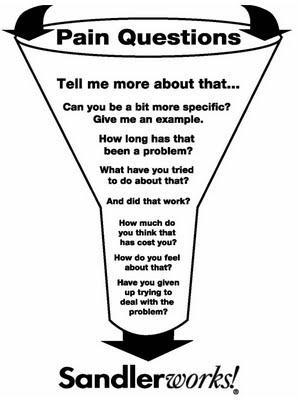
In sales, we’re taught to always be asking questions… more questions, less talking. The more you can get your prospect to talk, the better the sales call goes. If you’re the one doing all the talking, then you’re heading for failure from the beginning. Asking the right questions and listening to your prospect are key.
In Sandler Sales Training, we’re actually taught to ask a specific series of questions that ultimately lead a prospect from an intellectual “problem” to an emotional “pain.” These eight pain questions in sales are powerful ones, and even if you’re not Sandler trained, this process can work for you, too. (See the Sandler sales pain funnel questions infographic above.)
However, there’s one question in this process that – at least for me – is one I easily forget.
“What have you tried to do about that?”
Asking my prospect about her problems, getting examples, understanding how it’s affecting the bottom line – these are all questions that flow naturally from my mouth now after over three years in Sandler training; and they give me some great information about her situation. But, if I skip the question about what’s been done to this point to solve her problems, I completely miss out on one major factor: Is she even willing to DO anything about her problem/pain?
Don’t Just Sell to the Pain
Once I uncover some pain, I tend to jump right in to how we can help her relieve that pain, how our services can solve her problem. But, if she hasn’t been willing to make any changes up to this point, why should I think she’d start now?
Sure, it’s possible this is a new problem and it hasn’t been around long enough for her to have already tried something to fix it. But, if I don’t ask, I won’t know that.
Uncovering a problem is just the beginning. It’s my job as a salesperson to find out as much information as possible, so I can help determine whether my company/product/service is a good fit for the person on the other side of the table. If I pounce on the first mention of a problem, I’m not focused on helping solve a problem – I’m focused on selling something to someone.
Be Diligent in Your Questions
Questions are essential to a sales call. Typically, the more you ask, the better. But, to be truly effective, those questions must have a purpose, and you have to be diligent about learning what’s been done in the past to address the prospect’s problem. If it’s been a problem for years and she’s never done a thing (or done very little), question her intent. You might be wasting your time with something that’s not that important to her.
Thank you to Matt White for sharing. Matt is the owner of JoltCMS, where he helps businesses help their customers.
Interested in Sandler Training for you and your sales team? Contact us today to learn more.

